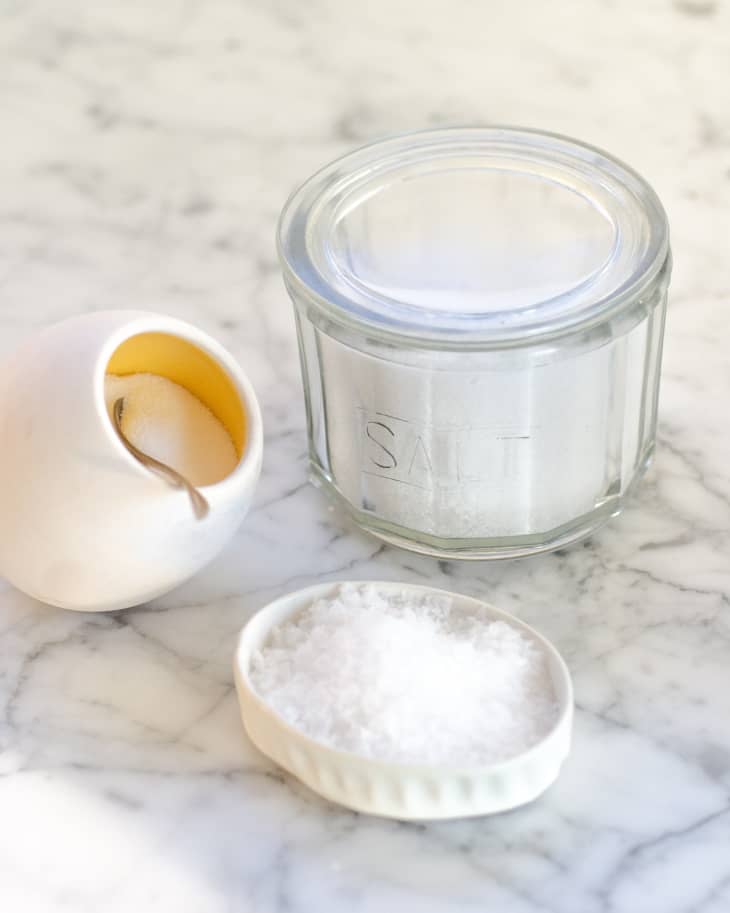The 3 Kinds of Salt I Always Have in My Kitchen
If I had to choose one ingredient that reliably causes confusion in recipes, it would, strangely, be the simplest of all: salt. Kosher salt, coarse salt, sea salt — which one is best? Why do we use different sorts?
We’ve talked about these questions
many times
1. Table Salt (Fine Salt)
Fine table salt is just what it sounds like: fine salt. When we call for salt in recipes at The Kitchn, fine table salt is what we mean. This is fairly standard among cookbooks and other recipe sources. I usually buy iodide-free salt because I don’t like the faintly bitter taste iodide adds. Because table salt has fine, evenly-shaped grains, it packs densely and can be measured with precision, so we use it any time you need a precise amount of salt.
- What it is: Fine salt, also called table salt or common salt
- How I use it: To season with precision. In any recipe that calls for salt. Baking recipes. Any recipe where salt needs to be measured closely.
- What matters (and what doesn’t): This is a huge pet peeve I have: when recipes call for “fine sea salt.” The designation of “sea salt” is completely meaningless when it comes to table salt. Once salt is this fine, most, if not all, impurities have been eliminated, and the product is pure sodium chloride. Whether it came directly from the sea, or from a mine (a mine that was at one time an ancient sea) the term “sea” salt in this case is utterly meaningless. Sea salt is not more pure, or more healthy, or better for you. Table salt is table salt, chemically speaking, especially when comparing non-iodized salt to non-iodized salt.
→ Salt vs. Sodium: What’s the Difference Between Salt & Sodium?
2. Coarse Kosher Salt
Nearly all salt is kosher. The reason “kosher” salt has its name, however, is not due to Jewish dietary guidelines, but to its role in koshering and pickling. Kosher salt was used to help remove blood from meat, before kosher meat became more available commercially. (Read more of its history here.)
The identifying factor of kosher salt is that it is chunky or coarse, although here at The Kitchn we always say “coarse kosher salt” just to add another layer of specificity. Why do I have kosher salt in my kitchen? Because it is chunky and easy to see when I apply it by hand.
- What it is: Coarse kosher salt
- How I use it: To season visually or to taste. For salting food when I don’t need a precise measurement, but just want to season the food. Kosher salt is rough and big and easy to sprinkle and to eyeball; unlike fine salt, I can see when I’ve sprinkled enough big kosher salt crystals on a steak or cooked vegetables.
- What matters (and what doesn’t): There is a wide range of coarseness in kosher salt brands, from the Morton’s pictured above (about the size of salt you’d find on a pretzel) to huge crystals. That’s why it should not be used in recipes where real precision is needed. If a recipe calls for kosher salt it should specify a range and encourage you to season to taste. And again, like the table salt above, salt is salt. There is no benefit to “sea salt” or any difference in chemical makeup between kosher salt and table salt. The differences are purely in the shape and size of the grain.
→ How salt is made commercially: From Ocean to Box: How Sea Salt Is Harvested
3. Flaky Finishing Salt
Flaky finishing salt is the third kind of salt I keep in my kitchen. I especially love Maldon, but there are hundreds of options to be found here. Unlike table salt and kosher salt, which have even shapes to their crystals, finishing salt has been allowed to form rough, flat, or spiky crystals that are unexpected and often flaky in a very delicious way. Finishing salt is used as the absolute last touch in dishes where the uneven and unpredictable flakes of salt create tiny explosions of salty flavor.
- What it is: Flaky sea salt
- How I use it: To season a final dish. As a last finishing touch on salads, meat, and grains, plus desserts.
- What matters (and what doesn’t): Like table salt and kosher salt, flaky salt is usually pure sodium chloride, although you do find some small color and flavor variations in exotic salts from around the world that still have some minerals and impurities included. Any health benefit claims upon these minerals are extremely dubious but sometimes you will find the interesting flavors and colors a luxurious addition to certain foods.
→ How finishing salt is made in small batches:
Hand-Harvesting Salt from the Sea with Ben Jacobsen of Jacobsen Salt in Portland
What kinds of salt do you keep in your kitchen? Are there any special or exotic finishing salts you especially love?
